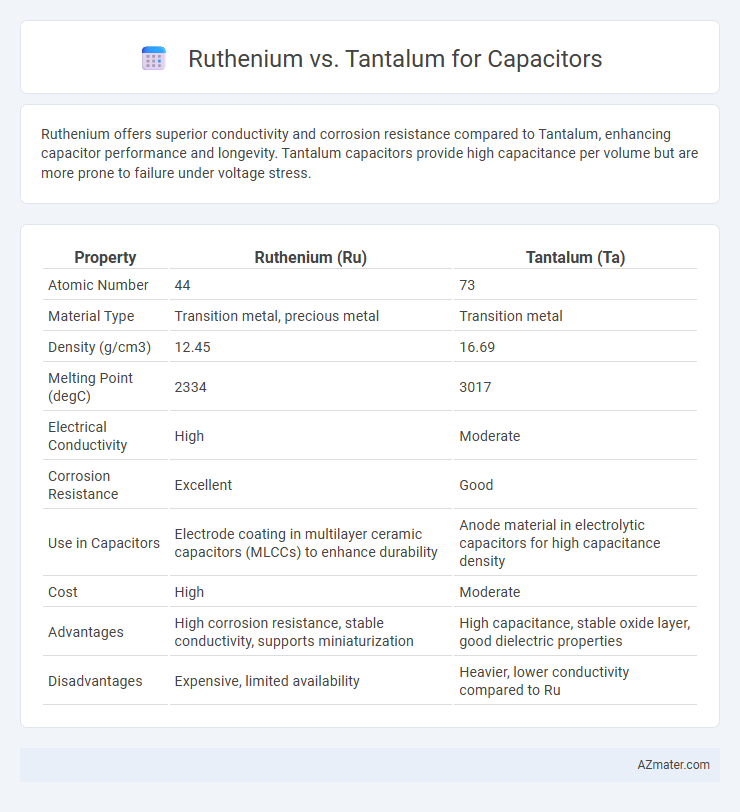Ruthenium offers superior conductivity and corrosion resistance compared to Tantalum, enhancing capacitor performance and longevity. Tantalum capacitors provide high capacitance per volume but are more prone to failure under voltage stress.
Table of Comparison
| Property | Ruthenium (Ru) | Tantalum (Ta) |
|---|---|---|
| Atomic Number | 44 | 73 |
| Material Type | Transition metal, precious metal | Transition metal |
| Density (g/cm3) | 12.45 | 16.69 |
| Melting Point (degC) | 2334 | 3017 |
| Electrical Conductivity | High | Moderate |
| Corrosion Resistance | Excellent | Good |
| Use in Capacitors | Electrode coating in multilayer ceramic capacitors (MLCCs) to enhance durability | Anode material in electrolytic capacitors for high capacitance density |
| Cost | High | Moderate |
| Advantages | High corrosion resistance, stable conductivity, supports miniaturization | High capacitance, stable oxide layer, good dielectric properties |
| Disadvantages | Expensive, limited availability | Heavier, lower conductivity compared to Ru |
Introduction to Ruthenium and Tantalum Capacitors
Ruthenium and tantalum capacitors are vital components in electronic circuits, each offering distinct benefits based on their material properties. Ruthenium capacitors provide excellent conductivity and stability due to the metal's high corrosion resistance and robust oxide layer, making them suitable for high-frequency applications. Tantalum capacitors feature a dense oxide layer that ensures high capacitance per volume and reliable performance in power-sensitive devices.
Material Properties: Ruthenium vs Tantalum
Ruthenium exhibits excellent corrosion resistance and high electrical conductivity, making it ideal for enhancing capacitor electrode performance, while tantalum offers superior dielectric properties and stability under high voltage. Ruthenium's ability to form thin, robust oxide layers contributes to lower equivalent series resistance (ESR) in capacitors compared to tantalum. Tantalum's high melting point and capacitance per volume result in compact, reliable capacitors suitable for demanding applications.
Capacitance and Performance Comparison
Ruthenium exhibits superior capacitance density and leakage current characteristics compared to tantalum, making it ideal for high-performance capacitors in miniaturized electronic devices. Tantalum capacitors provide stable performance and reliable capacitance but often suffer from higher equivalent series resistance (ESR) and limited frequency response relative to ruthenium-based capacitors. The enhanced conductivity and oxidation resistance of ruthenium contribute to improved capacitance retention and longer lifecycle in demanding applications.
Voltage Ratings and Stability Differences
Ruthenium-based capacitors typically offer higher voltage ratings, reaching up to 450V, compared to tantalum capacitors which commonly max out around 35-50V, making ruthenium suitable for high-voltage applications. Stability in ruthenium capacitors shows enhanced temperature tolerance and reduced leakage current due to the metal's robust oxide layer, while tantalum capacitors provide stable capacitance but are more susceptible to dielectric breakdown under voltage spikes. These differences make ruthenium capacitors preferable for reliability in harsh electrical environments, whereas tantalum capacitors are favored for cost-effective, lower voltage applications.
ESR (Equivalent Series Resistance) Analysis
Ruthenium-based capacitors exhibit significantly lower Equivalent Series Resistance (ESR) compared to tantalum capacitors, resulting in better high-frequency performance and reduced heat generation. The ESR of ruthenium capacitors typically measures in the milliohm range, enhancing efficiency in power electronics and RF applications. In contrast, tantalum capacitors show higher ESR values due to their electrolyte composition, limiting their suitability for high-current, low-ESR requirements.
Reliability and Lifespan of Capacitors
Ruthenium and tantalum are critical materials used in capacitor electrodes, with tantalum capacitors renowned for their high volumetric efficiency and long lifespan, often exceeding 10,000 hours under rated conditions. Ruthenium-enhanced capacitors offer improved reliability through increased corrosion resistance and reduced leakage current, which contribute to enhanced operational stability in harsh environments. However, tantalum capacitors typically exhibit superior long-term reliability in electronic circuits due to their well-established dielectric properties and robust failure modes.
Applications in Modern Electronics
Ruthenium and tantalum are critical materials in capacitor technology for modern electronics, with ruthenium often used in ruthenium oxide capacitors due to its excellent conductivity and stability at high temperatures, making it ideal for automotive and aerospace applications. Tantalum capacitors are highly valued in portable electronic devices such as smartphones, tablets, and laptops because of their high capacitance per volume, reliability, and long lifecycle. Both materials contribute to advancements in energy storage solutions, where ruthenium's robustness benefits harsh environments and tantalum's compact size supports miniaturization in consumer electronics.
Cost and Availability Factors
Ruthenium offers a lower cost advantage over tantalum, primarily due to its more abundant supply and lower extraction expenses. Tantalum is rarer, leading to higher prices and potential supply chain risks, especially with geopolitical constraints impacting availability. When selecting capacitors, ruthenium-based options provide enhanced cost efficiency and supply stability compared to tantalum counterparts.
Environmental and Safety Considerations
Ruthenium and tantalum capacitors each present distinct environmental and safety considerations; ruthenium, used in thin-film capacitors, offers higher corrosion resistance and lower risk of toxic byproducts during disposal compared to tantalum, which raises concerns due to the mining impact of tantalum ore and potential for hazardous electrolyte leaks in tantalum capacitors. The extraction of tantalum is often associated with conflict minerals and significant ecological disruption, whereas ruthenium, a rare platinum-group metal, has a smaller environmental footprint but limited availability. In terms of safety, tantalum capacitors can suffer catastrophic failure if exposed to voltage spikes, posing fire hazards, whereas ruthenium-based capacitors generally provide greater thermal stability and reduced risk under stressful conditions.
Choosing Between Ruthenium and Tantalum for Your Designs
Ruthenium and tantalum are critical materials in capacitor design, where ruthenium offers superior corrosion resistance and stable electrical conductivity, making it ideal for high-frequency applications. Tantalum excels in forming dense, reliable oxide layers that provide high capacitance and voltage stability, especially suited for portable electronics and demanding environments. Selecting between ruthenium and tantalum depends on performance requirements, cost constraints, and environmental stability, with ruthenium favored for enhanced durability and tantalum preferred for cost-effective, high-capacitance solutions.

Infographic: Ruthenium vs Tantalum for Capacitor
 azmater.com
azmater.com